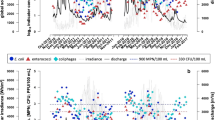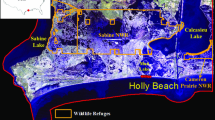Abstract
The Illinois River Watershed is a multi-facet basin with ecological and economic importance to its local stakeholders in northwest Arkansas and northeast Oklahoma, USA. The numbers, transport and sources of fecal bacteria in streams was identified as a research priority of the USDA NRI Water and Watershed Program in 2006, and the objective of this study was to evaluate the relation between fecal bacteria and other measured physicochemical parameters in water samples collected from selected sites throughout the Illinois River Watershed. An existing database (i.e., National Water Information Systems, NWIS) from the US Geological Survey (USGS) was used in this project. The data obtained includes discharge, pH, temperature, dissolved oxygen, Escherichia coli (E. coli), fecal coliform, and fecal streptococci among several other physic-chemical parameters. A synthetic model, based on multi-regression analysis, was developed to predict fecal bacteria numbers at these selected sites based on available USGS NWIS data, and the multiple regressions were significant at almost every site for all three bacteria groups. However, the physicochemical parameters used in the equations were very different across sites and fecal bacteria groups, suggesting that the development of such predictive models is site and bacteria group specific even within one watershed.
Similar content being viewed by others
References
Ashbolt, N. J., Grabow, W. K., & Snozzi, M. (2001). Indicators of microbial water quality. In L. Fewtrell & J. Bartram (Eds.), Water quality: Guidelines, standards and health (pp. 289–316). London: IWA.
Baxter-Potter, W. R., & Gilland, W. R. (1988). Bacterial pollution in runoff from agricultural lands. Journal of Environmental Quality, 17, 27–34.
Bossong, C. R., Stevens, M. R., Doerfer, J. T., & Glass, B. R. (2006). Summary and evaluation of the quality of stormwater in Denver, Colorado, water years 1998-2001: U.S. Geological Survey Scientific Investigations Report 05–5150. 94 pp.
Christensen, V. G. (2001). Characterization of surface-water quality based on real-time monitoring and regression analysis, Quivira National Wildlife Refuge, south-central Kansas, December 1998 through June 2001. Water-Resources Investigations Report 01-4248. 33 pp.
Christensen, V. G., Jian, X., & Ziegler, A. C. (2000). Regression analysis and real-time water-quality monitoring to estimate constituent concentrations, loads, and yields in the Little Arkansas River, south-central Kansas, 1995-99. Water Resources Investigations Report 00-4126. 36 pp.
Christensen, V. G., Rasmussen, P. P., & Ziegler, A. C. (2002). Real-time water quality monitoring and regression analysis to estimate nutrient and bacteria concentrations in Kansas streams. Water Science and Technology, 45(9), 205–219.
Clark, M. L., & Norris, J. R. (2000). Occurrence of fecal coliform bacteria in selected streams in Wyoming, 1990–99. Water-Resources Investigations Report 00-4198. 8 pp.
Craig, D. L., Fallowfield, H. J., & Cromar, N. J. (2001). The effects of temperature and sediment characteristics on survival of Escherichia coli in recreational coastal water and sediment. Environmental Health, 1, 43–51.
Edwards, D. R., Coyne, M. S., Daniel, T. C., Vendrell, P. F., Murdoch, J. F., & Moore, P. A., Jr. (1997). Indicator bacteria concentrations of two northwest Arkansas streams in relation to flow and season. Transactions of the American Society of Agricultural Engineers, 40(1), 103–109.
Eleria, A., & Vogel, R. M. (2005). Predicting fecal coliform bacteria levels in the Charles River, Massachusetts, USA. Journal of the American Water Resources Association, 41(5), 1195–1209.
Fries, J. S., Characklis, G. W., & Noble, R. T. (2006). Attachment of fecal indicator bacteria to particles in the Neuse River Estuary. Journal of Environmental Engineering, 132(10), 1338–1345.
Galloway, J. M., Evans, D. A., & Green, W. R. (2005). Comparability of suspended-sediment concentration and total suspended-solids data for two sites on the L’Anguille, Arkansas, 2001 to 2003. US Geological Survey Scientific Investigation Report 05-5193, 16 pp.
Green, W. R., & Haggard B. E. (2001). Nitrogen and phosphorus concentrations and loads in the Illinois River, Arkansas, 1997–1999. US Geological Survey Water Resources Investigation Report 01-4217. 12 pp.
Guber, A. K., Shelton, D. R., Pachepsky, Y. A., Sadeghi, A. M., & Sikora, L. J. (2006). Rainfall-induced release of fecal coliforms and other manure constituents: comparison and modeling. Applied and Environmental Microbiology, 72(12), 7531–7539.
Habteselassie, M., Bischoff, M., Blume, E., Applegate, B., Reuhs, B., Brouder, S., et al. (2008). Environmental controls of the fate of Escherichia coli in soil. Water, Air, and Soil Pollution, 190, 143–155.
Hyer, K. E., & Moyer, D. L. (2003). Patterns and sources of fecal coliform bacteria in three streams in Virginia, 1999-2000. U.S. Geological Survey Water-Resources Investigations Report 03-4115. 84 pp.
Jamieson, R. C., Joy, D. M., Lee, H., Kostaschuk, R., & Gordon, R. J. (2004). Persistence of enteric bacteria in alluvial streams. Journal of Environmental Engineering, 3, 203–212.
Jamieson, R. C., Joy, D. M., Lee, H., Kostaschuck, R., & Gordon, R. (2005). Transport and deposition of sediment-associated Escherichia coli in natural streams. Water Research, 39, 2665–2675.
Lipp, E. K., Kurz, R., Vincent, R., Rodriguez-Palacios, C., Farrah, S. R., & Rose, J. B. (2001). The effects of seasonal vairability and weather on microbial fecal pollution and enteric pathogens in a subtropical estuary. Estuaries, 24, 266–276.
Mallin, M. A., Williams, K. E., Esham, E. C., & Lowe, R. P. (2000). Effect of human development on bacteriological water quality in coastal watersheds. Ecological Applications, 10, 1047–1056.
McDowell, R. W. (2006). Contaminant losses in overland flow from cattle, deer, and sheep dung. Water, Air, and Soil Pollution, 174, 211–222.
Meals, D. W., & Braun, D. C. (2006). Demonstration of methods to reduce E. coli runoff from dairy manure application sites. Journal of Environmental Quality, 35, 1088–1100.
Metcalf & Eddy, Inc. (2003). Wastewater engineering: treatment disposal, and reuse (4th ed.). New York: McGraw-Hill.
Mishra, A., Benham, B. L., & Mostaghimi, S. (2008). Bacterial transport from agricultural lands fertilized with animal manure. Water, Air, and Soil Pollution, 189, 127–134.
Muirhead, R. W., Davies-Colley, R. J., Donnison, A. M., & Nagels, J. W. (2004). Faecal bacteria yields in artificial flood events: quantifying in-stream stores. Water Research, 38, 1215–1224.
Nevers, M. B., & Whitman, R. L. (2005). Nowcast modeling of Escherichia coli concentrations at multiple urban beaches of southern Lake Michigan. Water Research, 39, 5250–5260.
Niemi, R. M., & Niemi, J. S. (1991). Bacterial pollution of waters in Pristine and agricultural lands. Journal of Environmental Quality, 20(3), 620–627.
Noble, R. T., & Fuhrman, J. A. (2001). Enteroviruses detected by reverse transcriptase polymerase chain reactions from the coastal waters of Santa Monica Bay, California: low correlation to bacterial indicator levels. Hydrobiologia, 460, 175–184.
Petersen, J. C., Haggard, B. E., & Reed, W. R. (2002). Hydrologic characteristics of Bear Creek near Silver Hill and Buffalo River near St. Joe, Arkansas, 1999–2000. Water Resources Investigations Report 02-4024. Little Rock, Ark.: U.S. Geological Survey.
Rasmussen, P. P., & Ziegler, A. C. (2003). Comparison and continuous estimates of fecal coliform and Escherichia coli bacteria in selected Kansas streams, May 1999 through April 2002. USGS Water-Resources Investigations Report 03-4056. 87pp.
Schumacher, J. G. (2004). Fecal bacteria in streams and land-applied poultry litter in the Upper Shoal Creek Basin, southwestern Missouri, 2001–2002. U.S. Geological Survey Water Resources Investigations Report 03-4243. 39 pp.
Servais, P., Garcia-Armisen, T., George, I., & Billen, G. (2007). Fecal bacteria in the rivers of the Seine drainage network (France): sources, fate and modeling. Science of the Total Environment, 375, 152–167.
Soupir, M. L., Mostaghimi, S., Yagow, E. R., Hagedorn, C., & Vaughan, D. H. (2006). Transport of fecal bacteria from poultry litter and cattle manures applied to pastureland. Water, Air, and Soil Pollution, 169, 125–136.
Southwest Paddler (SWP). 2007. Illinois River Description. <http://www.southwestpaddler.com> Accessed February 1, 2007.
Sullivan, T. J., Snyder, K. U., Gilbert, E., Bischoff, J. M., Wustenberg, M., Moore, J., et al. (2005). Assessment of water quality in association with land use in the Tillamook Bay Watershed, Oregon, USA. Water, Air, and Soil Pollution, 161, 3–23.
Thiagarajan, A., Gordon, R., Madani, A., & Stratton, G. W. (2007). Discharge of Escherichia coli from agricultural surface and subsurface drainage water: tillage effects. Water, Air, and Soil Pollution, 182, 3–12.
Unc, A., & Goss, M. J. (2004). Transport of bacteria from manure and protection of water resources. Applied Soil Ecology, 25, 1–18.
United States Environmental Protection Agency (EPA). (2003). Bacterial water quality standards for recreational waters (Freshwater and Marine Waters) Status Report. EPA-823-R-03-008.
Vogel, J. R., Stoeckel, D. M., Lamendella, R., Zelt, R. B., Santo Domingo, J. W., Walker, S. R., et al. (2007). Identifying fecal sources in a selected catchment reach using multiple source-tracking tools. Journal of Environmental Quality, 63, 718–729.
Wahl, K. L., & Wahl, T. L. (1988). Effects of regional groundwater level declines on stream flow in the Oklahoma panhandle. In Proc. Water Use Data for Water Resources Management, 239–249. Middleburg, Va.: American Water Resources Association.
Wahl, K. L., & Tortorelli, R. L. (1997). Changes in flow in the Beaver–North Canadian River basin upstream from Canton Lake, western Oklahoma. Water Resources Investigations Report 96–4304. Little Rock, Ark.: U.S. Geological Survey.
Wang, L., Mankin, K. R., & Marchin, G. L. (2004). Survival of fecal bacteria in dairy cow manure. Transactions of the American Society of Agricultural Engineers, 47, 1239–1246.
White, K. L., Haggard, B. E., & Chaubey, I. (2004). Water quality at the Buffalo National River, Arkansas, 1991–2001. Transactions of the American Society of Agricultural Engineers, 47(2), 407–417.
Young, K. D., & Thackston, E. L. (1999). Housing density and bacterial loading in urban streams. Journal of Environmental Engineering, 125, 1177–1180.
Acknowledgements
This study was funded by the USDA NRI Water and Watersheds Program in 2006, and the authors would like to thank W.R. Green and T.S. Soerens for serving on this thesis committee and provided helpful comments on the thesis manuscript chapter. This paper simply evaluated fecal bacteria numbers in relation to existing recommendation from the US Environmental Protection Agency, and it does not suggest that these sites violate or exceed specific water quality standards in Arkansas and Oklahoma. The data used in this paper are available publicly, and the states can or have used this data to evaluate impairments.
Author information
Authors and Affiliations
Corresponding author
Rights and permissions
About this article
Cite this article
David, M.M., Haggard, B.E. Development of Regression-Based Models to Predict Fecal Bacteria Numbers at Select Sites within the Illinois River Watershed, Arkansas and Oklahoma, USA. Water Air Soil Pollut 215, 525–547 (2011). https://doi.org/10.1007/s11270-010-0497-7
Received:
Accepted:
Published:
Issue Date:
DOI: https://doi.org/10.1007/s11270-010-0497-7




